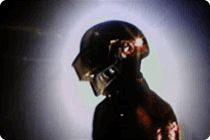Daft Punk: Thomas Bangalter Finds Live at the Heart of the Machine
For a couple of robots, Guy-Manuel de Homem-Christo and Thomas Bangalter do a good job of injecting soul into dance music. While 2001's Discovery and the lead-off single "One More Time" put Daft Punk on the cover of every cool music magazine, the duo have released a surprising number of hits for two guys in their twenties. 2005's Human After All expanded on their formula — a blend of catchy robotic vocoders, '80s disco-funk and progressive dance music, with Live as a tool to help assemble their creations. Ableton talked with Thomas Bangalter about how and why he uses Live.
"I jumped on the Live-user bandwagon around the release of Live 2.0. 'Elastic audio' were the words that drew me in. I use Live anywhere, anyhow. I use it on my laptop as a notepad for remembering and experimenting with musical ideas, and as a personal-computer game — because I have more fun with it than most video games. I use it in the studio for Daft Punk projects, tracking sessions, jamming, remixes, scoring and sound design."

Bangalter also turns to Ableton when he's looking for sonic warmth. "One of the things I prefer in Live is the proprietary Ableton effects plug-ins. They are amongst the warmest software effects. Sometimes I will import a Pro Tools track in Live, just to bounce it down with Ableton effects, to make it sound warmer and crisper, or dirty — I love dirt. I'm not a big ReWire fan, so I do it the old-school way, importing and exporting the sound files."
While Daft Punk record analog synths for thick melodies and lead lines, they're also fans of Ableton's built-in synthesizer. "Operator is one of the best soft synths out there, and I hate soft synths in general," says Bangalter. "It's great because it's got its own thing, it's not trying to emulate this or that." He adds: "Also, plug-in delay compensation in milliseconds is great. Live is getting better and better with each version."
Live's simplicity hasn't just influenced Bangalter's workflow, it's also influenced the way Daft Punk make music. "I tend to minimize my setup, and Live helped me do it. Live is one of the most transparent and creative softwares I have ever used. Its interface is streamlined and its features offer endless possibilities with a minimal approach. The whole process is easy, simple and fun, yet with accessible sophistication and professional results."
A problem with loop-based music and electronica in general is a tendency toward formulaic, static results. Bangalter has found Live to be a means of escaping these clichés. "The rule is: There are no rules. That is definitely the case for the freeform piece of software that is Live."
Check out www.daftpunk.com for more information.